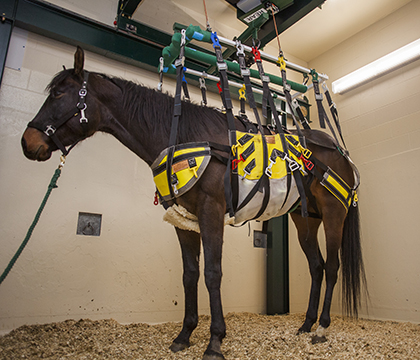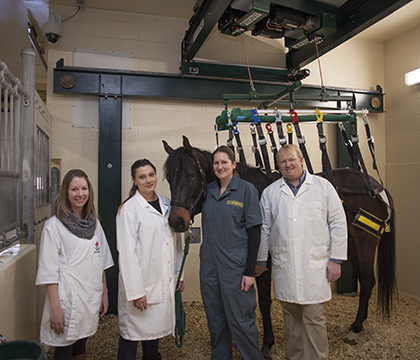
New device gives healing horses a lift
It's 8 a.m., and I'm all set for a long day of filling out paperwork for my summer job as a student researcher at the Western College of Veterinary Medicine (WCVM).
By Alison Williams
Less than an hour later I'm suturing up an eight-inch laceration on the shoulder of "Mama," one of our research horses, in the WCVM Veterinary Medical Centre's equine treatment room.
As I'm beginning to learn, horses seem to love finding creative ways of injuring themselves. Luckily for Mama, several dozen stitches and a dose of antibiotics will help her to heal up nicely.
But for many other equine injuries such as leg fractures, there is little hope of recovery — until now.
A team of researchers has partnered with RMD Engineering, a local Saskatoon engineering and manufacturing company, to design and build a one-of-a-kind robotic lift system. The lift will help rehabilitate horses suffering from acute injuries and other musculoskeletal problems by providing mobility, weight distribution and support.
The team's leader is Dr. Julia Montgomery, a large animal internal medicine specialist at the WCVM and my research supervisor. She and her colleagues are combining their expertise to find a solution for horses that sustain life-threatening injuries.
Research team members further include professors from the University of Saskatchewan's College of Engineering, an equine biomechanics specialist from the university's College of Kinesiology and Montgomery's husband James, a board-certified veterinary radiologist.
RMD Engineering owner Jim Boire says his company is built around the desire to find solutions to seemingly insurmountable problems. He has been involved with many other innovations at the U of S including the WCVM's bovine tilt table, a hydraulic device for lifting cows, and a large animal positioning system for the Canadian Light Source synchrotron.
"We're driven by helping people fix problems," says Boire. "That's what we like doing and that's really what our company does."
The idea for the equine lift originated from a similar lift system that RMD designed to help people with multiple sclerosis.
"When we meet people like James and Julia [Montgomery] that we get to work with, it just makes us smarter. We really push hard to make it a team, we run things as projects and everybody has their role," says Boire.
Hundreds of horses are fatally injured and euthanized every year in North America due to racetrack injuries, and a large majority of these injuries are skeletal fractures. But even horses that are used for pleasure riding can break a leg.
After a horse undergoes surgery to fix a leg fracture, it's normally confined to a stall and given medication to alleviate the pain. However, due to a horse's heavy weight and its strong flight response, recovery from musculoskeletal problems is fraught with complications and secondary issues such as supporting-limb laminitis – as was the case with the famous racehorse, Barbaro.
The Kentucky Derby winner shattered his right hind fetlock while racing in the Preakness Stakes on May 20, 2006. Equine surgeons successfully repaired his leg, but eight months later, Barbaro was euthanized after developing laminitis in his other feet.

Veterinarians regularly use slings to help support injured horses, but current designs significantly limit the animals' normal activity and support all of their weight on the thorax and abdomen. This leads to further problems because of compression on the lungs and development of pressure sores.
With the lift system, Montgomery says clinicians can reduce and redistribute the weight the horse is carrying dynamically. The system allows the animal to be mobile with its weight partially or fully supported by the lift.
"If we want to, we can allow the horse to move around so we don't have these issues with muscle wasting," says Montgomery. She adds that this function of the lift will also allow for more controlled rehabilitation of horses.
Leg fractures are one of the most common injuries that will benefit from this new technology, but the lift can also be used with equine patients suffering from other musculoskeletal and neurological problems.
Montgomery and her research team have been conducting initial trials with the horse lift. First, they're examining how three healthy horses — including Mama — tolerate hanging out for extended periods of time in the sling and prototype lift system. Next, they will use it with equine patients that have sustained limb fractures and would otherwise be euthanized.
These trials will help them determine how the lift affects the horse's behaviour and basic physiological parameters such as muscle enzymes and blood flow. They will also monitor the animals for pressure sores caused by the sling.
The research team believes that the unique horse lift will decrease the pain of recovery for equine patients, shorten their recovery periods and reduce complications. As a result, it will also help to decrease treatment costs and reduce emotional distress for both the owner and horse.
"[The lift] really provides a novel and unique solution to a very frustrating problem that currently doesn't have a solution," says Montgomery.
Alison Williams of Calgary, Alta., is a third-year veterinary student who was part of the WCVM's Undergraduate Summer Research and Leadership program in 2015. Alison's story is part of a series of stories written by WCVM summer research students.
As I'm beginning to learn, horses seem to love finding creative ways of injuring themselves. Luckily for Mama, several dozen stitches and a dose of antibiotics will help her to heal up nicely.
But for many other equine injuries such as leg fractures, there is little hope of recovery — until now.
A team of researchers has partnered with RMD Engineering, a local Saskatoon engineering and manufacturing company, to design and build a one-of-a-kind robotic lift system. The lift will help rehabilitate horses suffering from acute injuries and other musculoskeletal problems by providing mobility, weight distribution and support.
The team's leader is Dr. Julia Montgomery, a large animal internal medicine specialist at the WCVM and my research supervisor. She and her colleagues are combining their expertise to find a solution for horses that sustain life-threatening injuries.
Research team members further include professors from the University of Saskatchewan's College of Engineering, an equine biomechanics specialist from the university's College of Kinesiology and Montgomery's husband James, a board-certified veterinary radiologist.
RMD Engineering owner Jim Boire says his company is built around the desire to find solutions to seemingly insurmountable problems. He has been involved with many other innovations at the U of S including the WCVM's bovine tilt table, a hydraulic device for lifting cows, and a large animal positioning system for the Canadian Light Source synchrotron.
"We're driven by helping people fix problems," says Boire. "That's what we like doing and that's really what our company does."
The idea for the equine lift originated from a similar lift system that RMD designed to help people with multiple sclerosis.
"When we meet people like James and Julia [Montgomery] that we get to work with, it just makes us smarter. We really push hard to make it a team, we run things as projects and everybody has their role," says Boire.
Hundreds of horses are fatally injured and euthanized every year in North America due to racetrack injuries, and a large majority of these injuries are skeletal fractures. But even horses that are used for pleasure riding can break a leg.
After a horse undergoes surgery to fix a leg fracture, it's normally confined to a stall and given medication to alleviate the pain. However, due to a horse's heavy weight and its strong flight response, recovery from musculoskeletal problems is fraught with complications and secondary issues such as supporting-limb laminitis – as was the case with the famous racehorse, Barbaro.
The Kentucky Derby winner shattered his right hind fetlock while racing in the Preakness Stakes on May 20, 2006. Equine surgeons successfully repaired his leg, but eight months later, Barbaro was euthanized after developing laminitis in his other feet.

Veterinarians regularly use slings to help support injured horses, but current designs significantly limit the animals' normal activity and support all of their weight on the thorax and abdomen. This leads to further problems because of compression on the lungs and development of pressure sores.
With the lift system, Montgomery says clinicians can reduce and redistribute the weight the horse is carrying dynamically. The system allows the animal to be mobile with its weight partially or fully supported by the lift.
"If we want to, we can allow the horse to move around so we don't have these issues with muscle wasting," says Montgomery. She adds that this function of the lift will also allow for more controlled rehabilitation of horses.
Leg fractures are one of the most common injuries that will benefit from this new technology, but the lift can also be used with equine patients suffering from other musculoskeletal and neurological problems.
Montgomery and her research team have been conducting initial trials with the horse lift. First, they're examining how three healthy horses — including Mama — tolerate hanging out for extended periods of time in the sling and prototype lift system. Next, they will use it with equine patients that have sustained limb fractures and would otherwise be euthanized.
These trials will help them determine how the lift affects the horse's behaviour and basic physiological parameters such as muscle enzymes and blood flow. They will also monitor the animals for pressure sores caused by the sling.
The research team believes that the unique horse lift will decrease the pain of recovery for equine patients, shorten their recovery periods and reduce complications. As a result, it will also help to decrease treatment costs and reduce emotional distress for both the owner and horse.
"[The lift] really provides a novel and unique solution to a very frustrating problem that currently doesn't have a solution," says Montgomery.
Alison Williams of Calgary, Alta., is a third-year veterinary student who was part of the WCVM's Undergraduate Summer Research and Leadership program in 2015. Alison's story is part of a series of stories written by WCVM summer research students.
